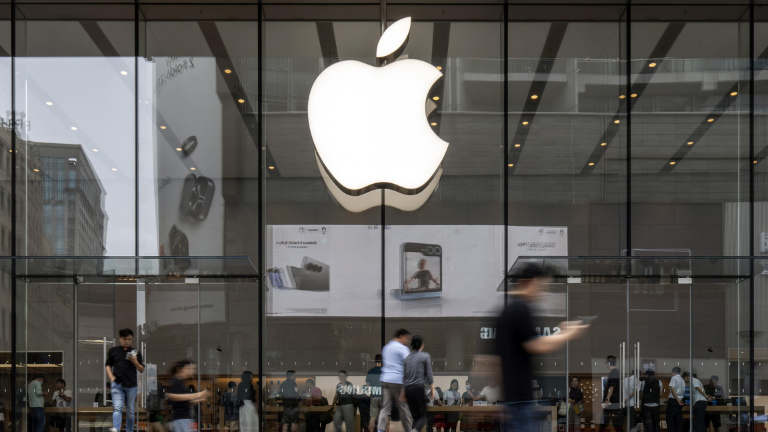Apple Manufacturing in India Faces Uncertainty Amid Potential US Tariffs
US Tariffs Threaten the Growth of Apple Manufacturing in India
The rapid expansion of Apple manufacturing in India is facing a potential roadblock as the US government considers imposing reciprocal tariffs on electronics and smartphones imported from India.
If implemented, this move could significantly impact Apple’s production and export strategy, particularly its iPhone exports from India to the US. The situation is equally concerning for India’s auto component industry, which heavily depends on exports to the American market.
With Apple manufacturing in India gaining momentum, a 16.5% tariff on Indian electronics in the US could disrupt Apple’s business model, making production in India less competitive compared to China.
Apple’s Export Boom from India to the US
Apple manufacturing in India has been growing at an unprecedented rate, with the tech giant increasingly using its Indian production facilities to export iPhones globally.
- India has become one of Apple’s largest global manufacturing hubs, with exports of iPhones estimated at $8-9 billion this financial year.
- The majority of Apple’s India-made iPhones are shipped to China, but a significant volume reaches the US duty-free under current trade agreements.
- Zero duty on Apple’s Indian exports to the US has made Apple manufacturing in India a highly profitable venture for the company.
However, if the US imposes a reciprocal 16.5% tariff, it would reverse Apple’s cost advantage, making India a less attractive manufacturing base for the American tech giant.
Why the US is Considering Tariffs on Indian Electronics
The primary trigger for the US’s tariff considerations is India’s existing import duty structure:
- India imposes a 16.5% duty on smartphones and electronics imported into the country, making it expensive for US companies to sell in India.
- The US administration, under Trump, views this as an unfair trade practice and is considering retaliatory measures.
- If the US slaps a reciprocal duty on Indian-made electronics, it could jeopardize Apple’s current manufacturing strategy.
A key industry expert highlighted the concern:
“The fear of the industry is that if Trump really goes ahead and slaps a reciprocal duty of 16.5% on smartphones and electronics products being shipped out of India, it will immediately reverse the maths against our manufacturing strength.”
This move could force Apple to reconsider its India strategy, as producing in China—even with a 10% duty—may become a cheaper alternative.
How Apple Manufacturing in India Will Be Affected
If the US tariffs on Indian electronics materialize, it could have far-reaching consequences for Apple, Samsung, and Motorola, which currently manufacture and export their India-made devices to the US.
- A 16.5% import duty on Indian smartphones in the US would make Apple’s “Make in India” initiative significantly less attractive.
- China’s 10% import duty would become a better alternative for Apple, despite ongoing US-China trade tensions.
- Samsung and Motorola, which also export India-made devices to the US, would suffer similar profitability concerns.
One Apple supplier emphasized:
“That would mean our manufacturing will become more expensive than China due to the higher duty. So, Apple will really have no benefit of making in India and would rather find it beneficial to ship its products out of China at 10% duty.”
This would disrupt Apple’s long-term goal of reducing dependency on China by shifting production to India and Vietnam.
Impact on India’s Auto Component Exports
The potential US tariffs will not just affect Apple manufacturing in India but also India’s auto component industry, which exports billions of dollars worth of parts to the US.
- India exports auto components worth $7 billion to the US annually, while American imports into India stand at just $1.4 billion.
- Currently, Indian auto parts enter the US at a low duty of 1-2% (zero for some items), whereas India imposes duties ranging from 7.5% to 15% on US imports.
If the US imposes reciprocal tariffs on Indian auto components, it could damage the competitiveness of Indian suppliers, though the overall impact may be limited due to India’s small share in the US market.
An Indian auto industry expert explained:
“We are just about $7 billion to the overall $300-billion worth of component imports that the US carries out.”
While the electronics sector faces a larger threat, auto component makers still risk losing valuable business if US tariffs increase.
What’s Next for Apple Manufacturing in India?
With Apple manufacturing in India playing a crucial role in global supply chains, the US-India trade tensions could force Apple to rethink its India strategy.
Possible Outcomes:
- Apple May Shift More Production Back to China
- If India’s exports to the US face a 16.5% tariff, Apple may increase production in China, where the 10% tariff is still lower.
- India May Reduce Import Duties to Avoid Retaliation
- The Indian government may consider reducing its 16.5% import duty on electronics to prevent US retaliatory tariffs.
- Apple Could Diversify Manufacturing Locations
- Apple may increase production in Vietnam, Thailand, or other Southeast Asian nations to mitigate potential US-India trade risks.
For now, Apple manufacturing in India continues to expand, but uncertainty over US tariffs poses a serious risk to its long-term sustainability.
Will Apple’s India Expansion Survive US Trade Tensions?
The success of Apple manufacturing in India has been built on favorable trade policies and cost advantages. However, if the US follows through with its 16.5% tariff plan, it could disrupt Apple’s entire India production model.
For now, India remains a key manufacturing hub for Apple, but future expansion will depend on:
- US trade policies under the new administration.
- India’s willingness to adjust its import duty structure.
- Apple’s global supply chain strategies.
With tensions rising, the future of Apple manufacturing in India hangs in the balance, as both the Indian government and Apple executives prepare for potential disruptions ahead.







